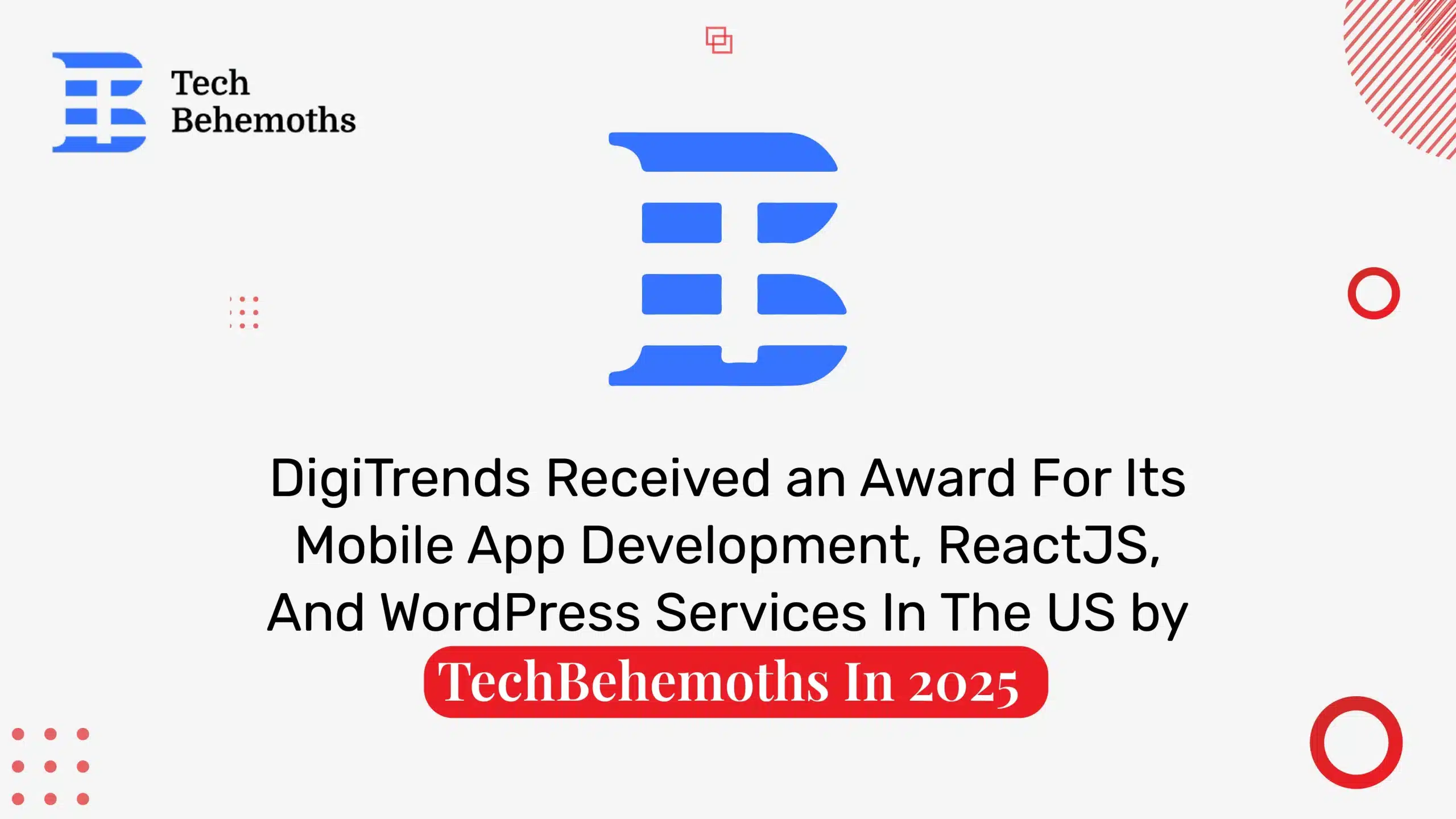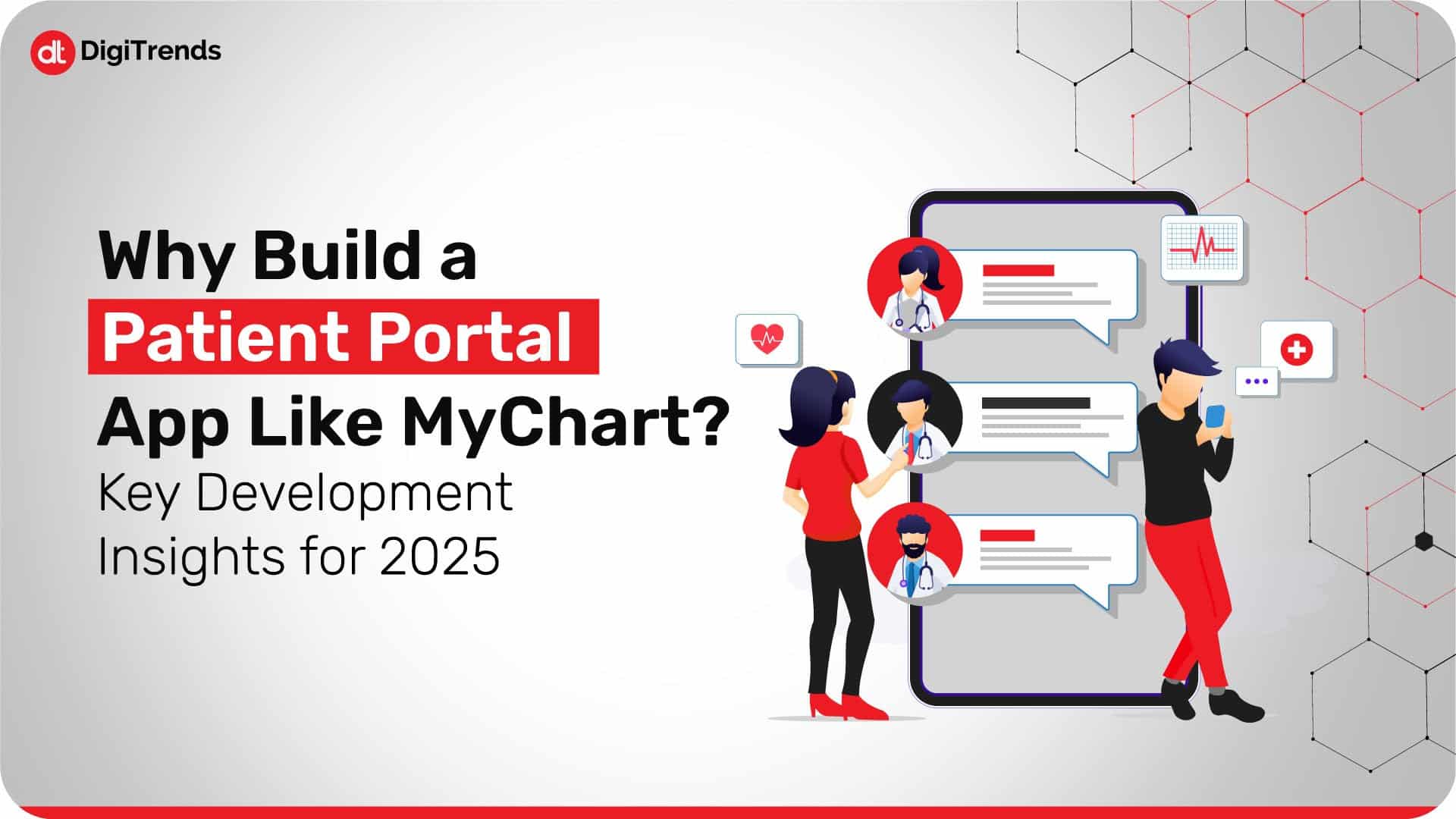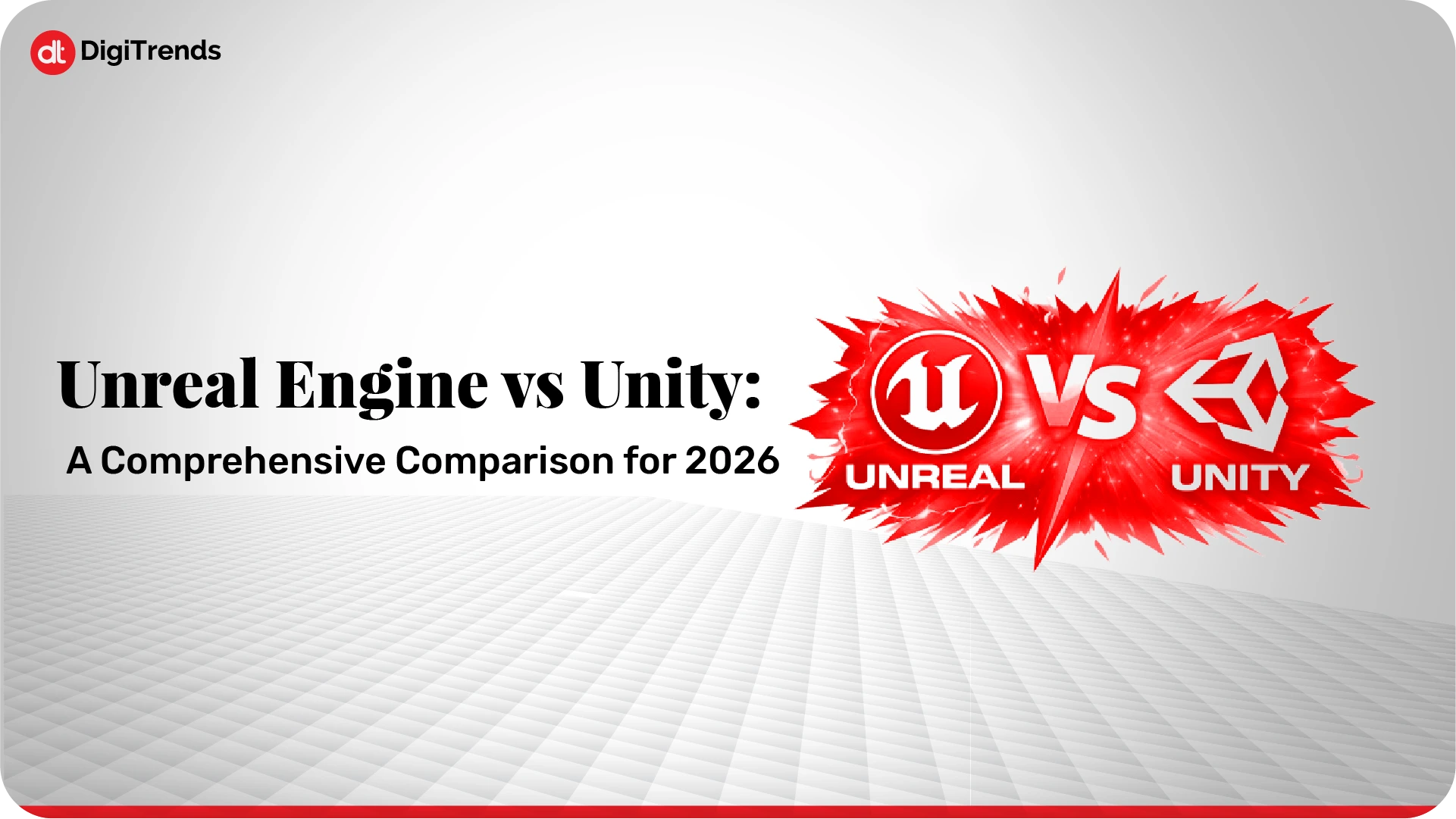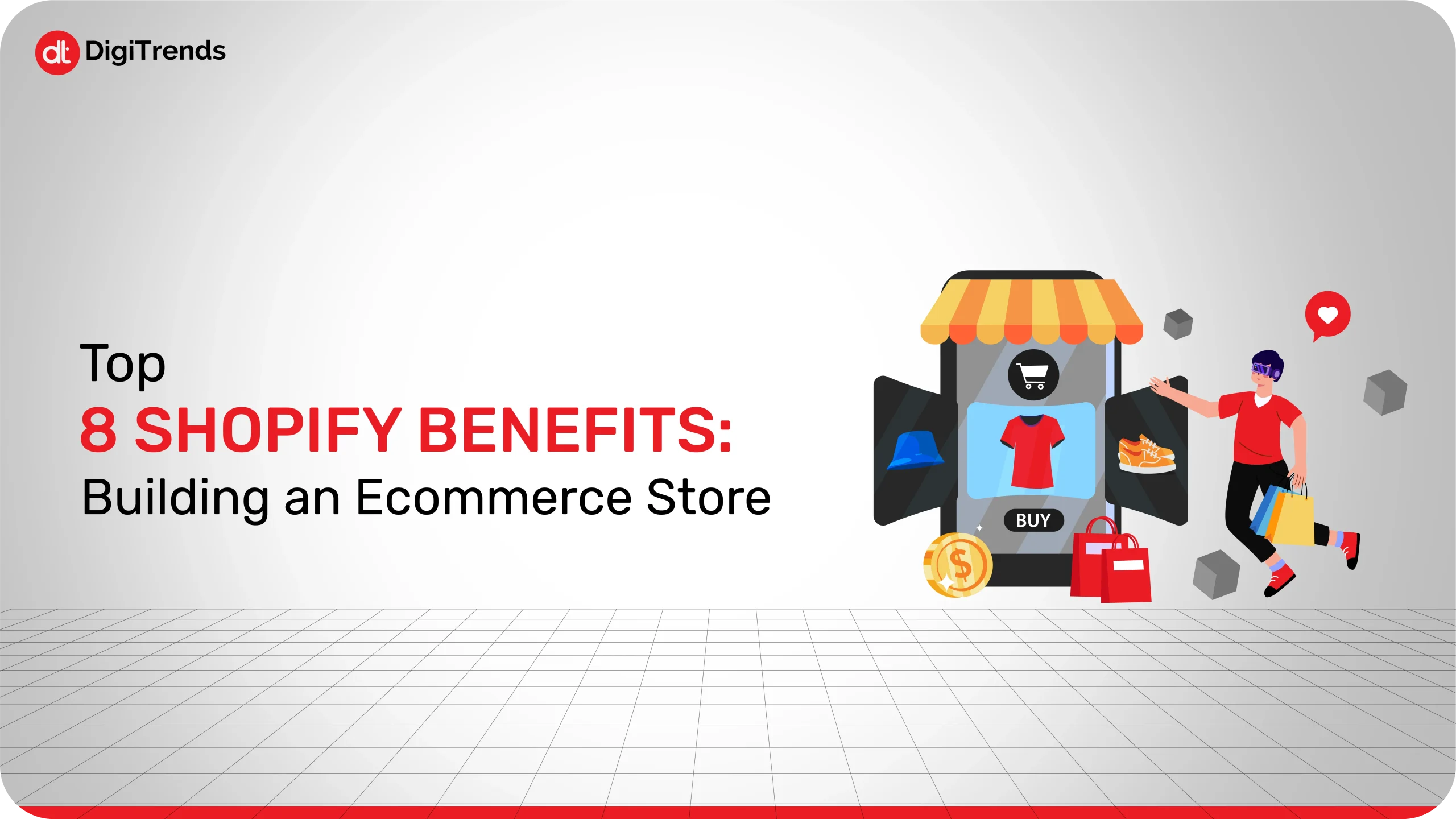“ Please reschedule my appointment! I won’t be able to make it.’’
How many times have you made calls like these to cancel medical appointments?
Probably too many times!
We live in a world where everyday tasks like grocery and money transfers are done through a few taps on the screen, similarly, people now wish to manage their health through their mobile screens and in today’s digital world, managing health does not just mean checking heart rate through health apps, but proper health management like appointment scheduling, prescription management, reports and records, with no need to visit the hospital or clinics.
This is where new patient portal apps such as MyChart come in, providing patients with an easy way to handle their healthcare online or on the go. Even though MyChart and other similar apps can be useful, they usually won’t address the individual workflows and demands of your hospitals or clinics.
The solution? A custom-built patient portal that reflects the way you deliver care.
In this blog, we’ll dive into why healthcare apps like MyChart are a hit and what it takes to build a health management portal like MyChart in 2025.
Understanding MyChart: The Benchmark for Modern Patient Portals
Epic Systems is the team behind the MyChart patient app, which is commonly used and considered a key resource for patients in healthcare. It is a reliable healthcare platform where patients can consult their doctors online and benefit from services like making appointments, ordering medicine, viewing test results, and messaging each other. A medical records app like MyChart lets patients handle their health easily, reducing the usual problems of long waits, forgotten appointments, and filling out paperwork..
Patients can use MyChart to make or change appointments, get instant updates when needed, review their full medical records, including test outcomes, vaccination history, and summaries for their doctor visits, and talk safely with their medical team. In addition, healthcare providers often allow patients to pay bills online and handle their insurance through the patient portal app. One more reason MyChart is on top today is that it can be used with wearable devices and fitness apps, so patients can keep an eye on their vitals, activity, and wellness from a central location.
What works well for healthcare is making interactions easily understood, convenient, and accessible to users who are always on the go. On the other hand, MyChart is created to function the same way for every user. Healthcare organizations often discover that it doesn’t match their usual procedures, corporate style, or plans for engaging patients. That is why, by 2025, having a patient portal app made just for you that looks like MyChart is a wiser investment.
Why Build a Custom Patient Portal App in 2025?
Over the last few years, the use of digital technologies has increased in the healthcare sector, and it seems to be making a major change in 2025. Today, patients look for healthcare that is as easy and advanced as their other digital activities.
But here’s the challenge: basic patient portal apps often fall short. They may offer standard functionalities, but they lack the flexibility to reflect the unique workflows, branding, and patient engagement strategies of individual healthcare providers. Whether healthcare providers run a private clinic, a multi-location hospital, or a specialized care center, a custom patient engagement app allows them to design around their needs, not the limitations of pre-built software.
Here’s why building a custom patient portal app in 2025, like MyChart, is a strategic move that puts both patients and doctors at an advantage:
1. Patient Expectations Have Evolved
These days, patients are familiar with technology, are always busy, and expect fast service. It’s easy for people to watch their food on the way and manage their cash flow on mobile apps. So why can’t checking lab results or setting up a doctor’s visit be just as simple?
A patient engagement app, or a patient portal app meets these high expectations by providing a smooth, fast, and mobile-focused experience for users. Patients don’t have to struggle with tough menu options or stay on hold; everything they might need is just a couple of clicks away.
And the payoff? Better patient satisfaction, increased loyalty, and a stronger brand reputation.
2. Seamless Integration for Smarter Workflows
Today, successful operations in healthcare app development require technology that supports what healthcare providers or hospitals already have, not opposes it.
A patient portal developed for a specific hospital or clinic is customized to align with its operations, featuring EMR integration along with connections to lab management, billing, and scheduling systems. In turn, physical products, sales, and purchases are kept updated, multiple entries are no longer needed, and information remains unseparated.
It’s important to realize that it’s not just tech integration, but also having an effortless workflow for the employees. Reduced paperwork, instant updates and task routing are a few ways a linked portal improves efficiency and work pace for everyone on the team.
The result? Less hassle for admin and patients, both, and more efficient record-keeping.
3. Improved Patient Engagement and Retention
Using a simple patient portal helps with effective healthcare management and motivates patients to look after themselves. Different age groups and medical conditions can use personalized reminders for medications, monitor their condition over time, chat with caregivers and access custom-made information. With such a portal, individuals can work in partnership with their doctors regularly via ongoing messages and conversations.
In a competitive healthcare market, this kind of engagement is a powerful differentiator.
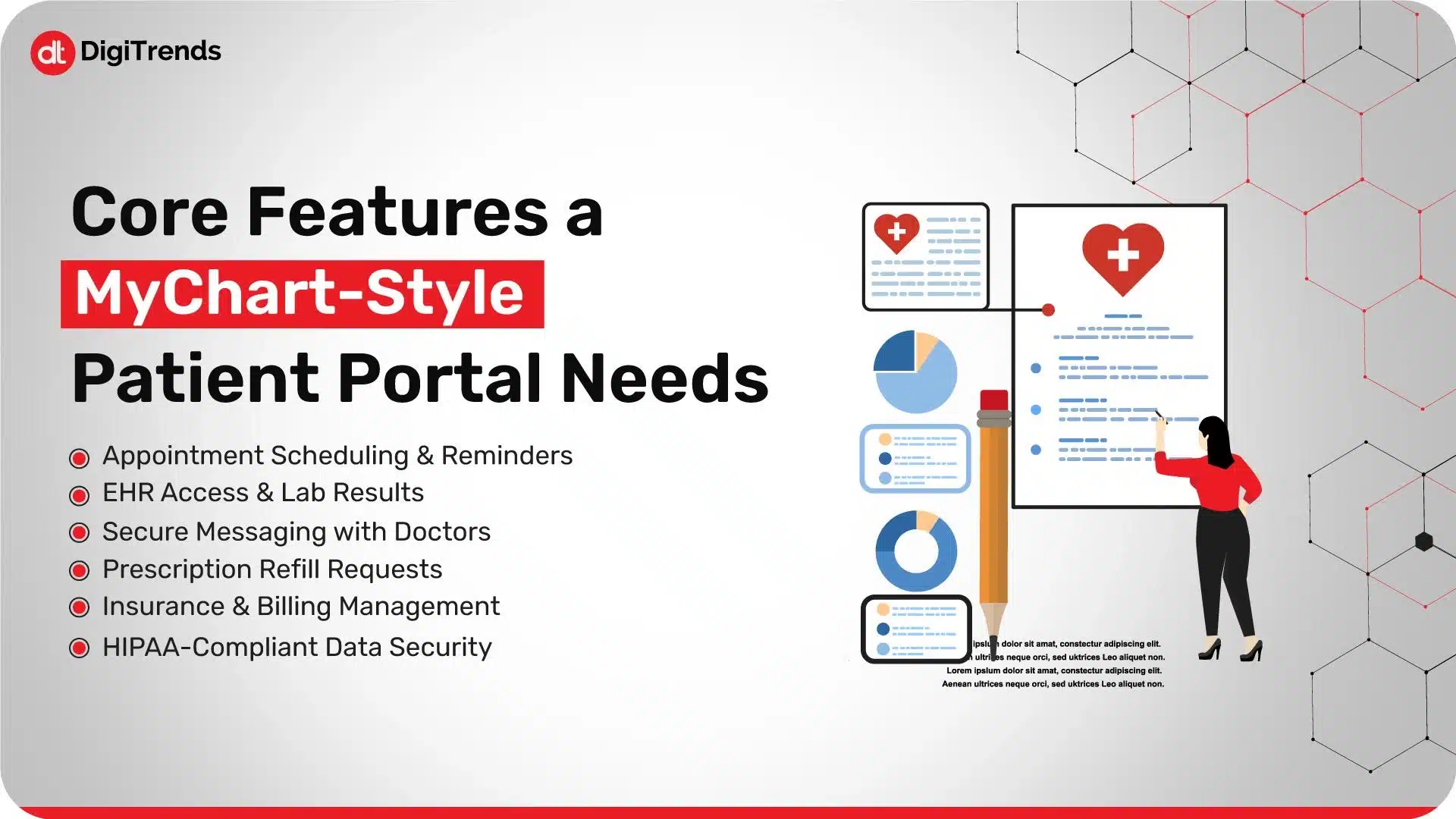
Core Features a Patient Portal App Needs
Creating a good patient portal app is not just about style; it makes taking care of yourself easier, provides transparent information, and fosters dependable relationships between providers and patients. There are some main points to focus on when starting healthcare portal development. Let’s have a look at the core features patient portal apps should have:
Appointment Scheduling & Reminders
Today’s patients are not interested in calling the main desk to set up appointments. A well-designed portal should enable patients to set, change, and cancel appointments instantly in the portal. Using reminders sent through text, email, or the application can save patients from not arriving on time and also help medical providers use their resources more effectively.
EHR Access & Lab Results
A must-have feature is on-demand access to electronic health records (EHRs), including medical history, test results, immunizations, and discharge summaries. It gives patients more knowledge and reduces the time staff must give to handling requests by hand.
Secure Messaging with Doctors
Patients should have the ability to communicate with the doctor or the healthcare team regarding any queries or clarification needed on medical instructions or for discussing reports. Patients should be able to do this without scheduling another appointment just for some clarity. This feature will save the time of both the patients and the healthcare providers.
Prescription Refill Requests
A MyChart-style app should enable patients to request refills instantly, track medication history, and receive alerts when it’s time to renew which would help in preventing missed doses and medication errors.
Insurance & Billing Management
Whether it is a healthcare portal or a food delivery portal, billing is often one of the most stressful aspects when managing it online. A good medical records app should provide transparent access to outstanding balances, downloadable invoices, insurance claims, and online payment options, making it easier for patients to manage the financial side of their care.
HIPAA-Compliant Data Security
Trust is the most important element of every healthcare app as they often include a patient’s medical records. It’s necessary to follow HIPAA regulations, as well as use encrypted data transmission, two-factor authentication, and secure login to safeguard patient information from breaches.
Having these flexible features in the system or using them without difficulties hasn’t been easy for most. A lot of healthcare app development teams and clinics have made improvements by looking at their patient portal differently. Organizations like DigiTrends have been present throughout this change, supporting healthcare providers in finding solutions that match the way they work.
Technical Requirements to Build a Scalable, Secure Health Portal in 2025
While the main part of the portal is designed for easy use and various functions, the back end should offer maximum protection and have room to grow. MyChart app development meets the rules set by authorities and integrates smoothly with the healthcare system.
1. Interoperability and Data Standards
Patient portal apps need to connect smoothly with the hospital’s EHR system, databases from laboratories, and pharmacy networks. This means that healthcare organizations need to back standards like HL7 and FHIR (Fast Healthcare Interoperability Resources). Because of these protocols, data from tests, summary notes, and referrals can be found in just one location.
2. Scalable Cloud Architecture
In 2025, most healthcare portals will be built on secure cloud platforms (like AWS, Azure, or Google Cloud) to ensure scalability, data redundancy, and uptime. Cloud-based architecture also enables real-time backups, disaster recovery, and the ability to handle traffic spikes, especially useful for large healthcare networks or during public health events.
3. Role-Based Access Control (RBAC)
It’s just as important to grant access to those who should have it, not only to lock access away from those who shouldn’t have it. A medical records app should use role-based access control (RBAC), which allows doctors, nurses, admins, and patients to access different features. Using this system protects confidential data and allows all members of the team to cooperate efficiently.
4. Data Encryption & Authentication Protocols
The healthcare development team needs to make sure that all patient data is encrypted when it’s being sent or stored, with standards like Advanced Encryption Standard (AES-256) and HTTPS/TLS. To prevent unauthorized users and account takeovers, the portal should depend on multifactor authentication (MFA) and offer secure session handling.
5. API-First Development for Future Flexibility
Building the backend with an application programming interface (API) at the start makes it simpler to include new features, create a mobile app, or link to other services as needed. As an illustration, APIs let patient portal apps talk to fitness trackers, telehealth systems, or artificial health bots, all without touching the main system.
6. Mobile Responsiveness and App Integration
A responsive and smooth user experience should be available for users on Android, iOS, or a desktop device. To ensure their portals perform well and are compatible everywhere, many modern patient portal designers use a progressive web app (PWA) or React Native as their framework.
Designing for Patients: The UX Advantage of Building a Custom Portal
MyChart app development is worth it because healthcare providers can build the patient experience just how they need it to be. It’s common for non-technical users to find that standard software solutions are difficult to operate and look old-fashioned. In comparison, building a portal from scratch helps them design a clear, simple layout that looks up-to-date, responsive, and uncomplicated.
Keep things simple by using dashboards, easy tools for managing appointments, detailed health summaries, and designs made for mobile.
Why Is 2025 a Great Year for Patient Portal App Growth?
There has been tremendous growth in the healthcare portal market recently, as digital solutions are now needed more often by the healthcare industry. According to Global Market Insights, the digital healthcare market is expected to grow from USD 387.8 billion in 2025 to USD 2.19 trillion in 2034. Because both caregivers and patients are doing more to handle health needs quickly, there has never been a better opportunity to enter this field.
An app similar to MyChart is designed to help people take charge of their health as the trend moves toward patient-focused care. Portals are becoming mainstream because people can now book doctor appointments, check lab results, communicate with their care team, and keep track of medications. According to Mordor Intelligence, the patient portal app market is estimated at USD 6.56 billion in 2025 and is expected to reach USD 15.52 billion by 2030, highlighting how essential these tools have become in the modern healthcare landscape. This growth is fueled by not only evolving patient expectations but also healthcare systems’ increasing focus on engagement, transparency, and digital efficiency.
If hospitals or clinics are considering building a patient portal app, they are not just keeping up. They are stepping into one of the fastest-growing segments of digital health with massive potential for long-term impact.
Real-World Success: How Patient Portal Apps Are Transforming Healthcare
Recognizing the advantages of using a custom patient portal app like the MyChart becomes easier once we look at how top healthcare providers have managed to implement them. The examples explain how the right digital tools can make a big difference in caring for patients, running hospitals, and improving healthcare quality.
1. Mayo Clinic’s Patient Portal App
Mayo Clinic is a private American academic medical centre. It is famous for its innovative healthcare and has built a patient portal app that connects well with its comprehensive EHR system. Patients can use this portal around the clock to find important health information, like lab test outcomes, medical imaging results, and a full summary of each visit. Through the app, patients can schedule appointments, message doctors and nurses securely, and ask for refills of prescription medicines.
There have been great outcomes from the policy. Appointment no-shows were cut by 25% at the Mayo Clinic after patients started to use simple health information and helpful communication features. Most importantly, patients said they felt better informed and more actively involved and this improved how well they followed the treatment plan and their health. Because there were fewer disruptions for administrators and a smoother workflow, clinicians could concentrate more on their patients.
2. Cleveland Clinic’s MyChart Implementation
Cleveland Clinic, a renowned non-profit academic medical center in the United States, chose MyChart app development and updated it to help its doctors and staff better suit their patients’ needs. Using their portal, patients can message their doctors, request prescription refills right away, and check their test results immediately. These tools helped patients wait far less for follow-ups and approval from the pharmacy.
Consequently, the company achieved several improvements in operations. The switch made the administrative staff note that fewer people were calling about bookings and medicine, so they could concentrate on harder tasks. Thanks to convenience and openness, the patients reported being happier and loyal to the healthcare system. Patients could easily follow their chronic disease progress and talk with their healthcare team using the portal.
3. Community Health Network’s Patient Portal App
Community Health Network, which handles the healthcare system of a variety of people in its community, opted for a custom patient portal app. Some of the features they provided were assistance in multiple languages, telehealth integration, and reminders to help patients manage care on their own.
Remote patient monitoring and consulting became possible with the patient engagement app during the COVID-19 pandemic, which helped maintain care for patients who had to stay apart. By customizing the portal based on its community, Community Health Network helped more members of underserved groups access and take part in their healthcare. Patients also avoided many emergency room visits since the portal made it possible for them to get help at the first sign of health problems.
These case studies certainly highlight a common theme: patient portal apps do much more than digitize basic healthcare tasks. They empower patients, optimize clinical workflows, and improve health outcomes by offering tailored solutions that generic platforms cannot match. Whether it’s reducing no-shows, speeding up prescription refills, or facilitating virtual care, investing in a custom patient portal app can deliver significant, measurable benefits for both providers and patients.
In the current digital healthcare age, healthcare organizations that listen to their patients and improve patient care through custom digital portals end up more successful, trusted and connected to their patients.
These examples demonstrate what happens when the needs of patients drive technology development. DigiTrends has previously supported both hospitals and startups in the same position, helping them turn good features into strengths in the healthcare industry.
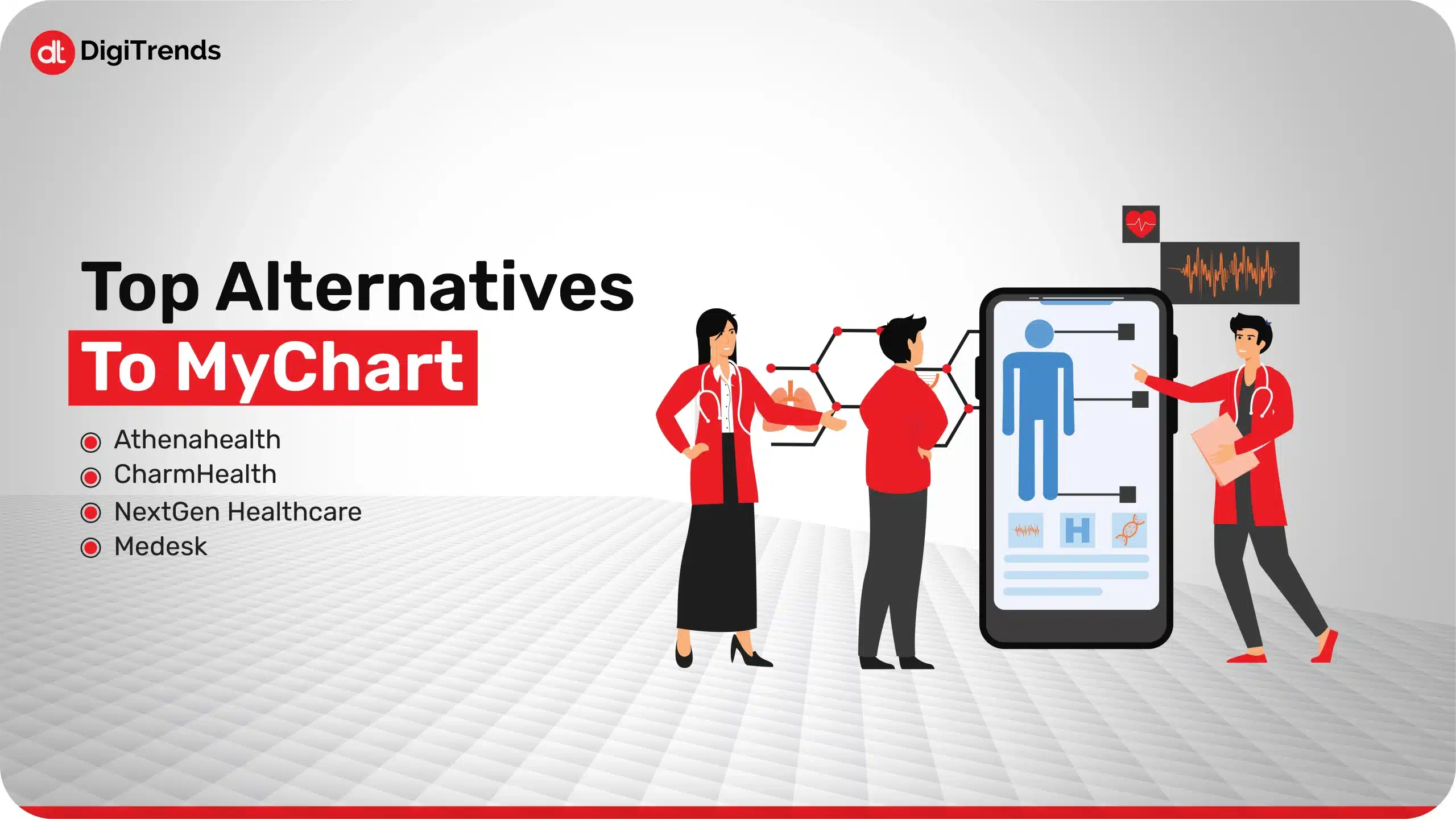
Top Alternatives to MyChart
MyChart app development is top-notch when it comes to patient portal apps. However, let’s take a look at some strong alternatives that also offer valuable features for healthcare access and management:
- Athenahealth: The company is recognized for cloud-based EHR software, makes it easy to handle patient appointments, bill clients, manage messages and coordinate care.
- CharmHealth: Many smaller clinics and independent practices use CharmHealth, which is simple to use, customizable, provides telehealth tools and has built-in billing hence, their budgets are not overstretched.
- NextGen Healthcare: NextGen Healthcare is for midsize to large practices. NextGen offers comprehensive EHR integration and patient portal solutions with advanced analytics, specialty-specific workflows, and strong interoperability capabilities.
- Medesk: Medesk is perfect for doctors and clinics that want a simple, straightforward package with normal features, including appointment schedules, medical records viewing, and quick messaging, all in multiple languages.
Conclusion
The healthcare sector is going through a digital transformation, especially after the pandemic. As this transformation is taking place, the expectations of patients from the healthcare system are also evolving rapidly. Healthcare app development is no longer a luxury but a requirement. Patients want the ability to schedule appointments, review test results, request refills, and communicate with providers on their terms, just as easily as they manage their finances or order food.
Patient portal apps like MyChart have set a new standard, but they’re not created according to the system and requirements of every hospital or clinic. Every healthcare organization has unique systems, priorities, and patient demographics. That’s why building a custom patient portal app that is designed according to their specific needs is a smart move in 2025. It’s a chance to improve healthcare delivery, gain patient trust, level up operations, and stay ahead in an increasingly competitive space.
The market trends of digital healthcare are clearly showing immense growth and widespread adoption. Now is the perfect time to invest in a custom patient portal app, designed specifically according to the hospital or clinic’s system. Whether it’s a hospital network, a private practice, or a specialty clinic, a personalized portal will not just become a tool but a foundation for a better and more connected healthcare experience.
It’s time to level up the game of healthcare and start thinking about custom solutions to enter the digitalized world of healthcare by building something that truly works for both the healthcare providers and the patients.

Frequently Asked Questions
A custom patient portal app is a digital health platform designed specifically for your healthcare organization’s needs. Unlike off-the-shelf solutions that offer generic features, a custom portal can be tailored to match your workflow, branding, compliance requirements, and patient expectations. It gives you more control over both the user experience and long-term scalability.
It’s important to remember that how much it costs to build a custom portal like MyChart depends on the needs of the hospital or clinic because it is an investment to be used for years to come. The price of upfront development is higher than generic options, but there will be more value over time since providers will be able to serve more patients, work efficiently and manage all the data.
Creating a patient portal can require between 4 to 9 months, depending on how many features it will have, how many systems it connects to and what rules it must follow. Team DigiTrends uses tested ways of working which help speed up the progress you make in digital health projects.
Of course, as long as compliance with healthcare rules is part of the plan from the beginning. All security features, like encrypting data, adding a second authentication step, and an audit log, are necessary.
Ease of use and the value found in the solution are important factors in getting users to use a product. The availability of mobile apps, appointment reminders, and easy messaging helps keep many patients involved regularly. Since a custom UI/UX gives the platform a known feel, more people tend to use it regularly.
